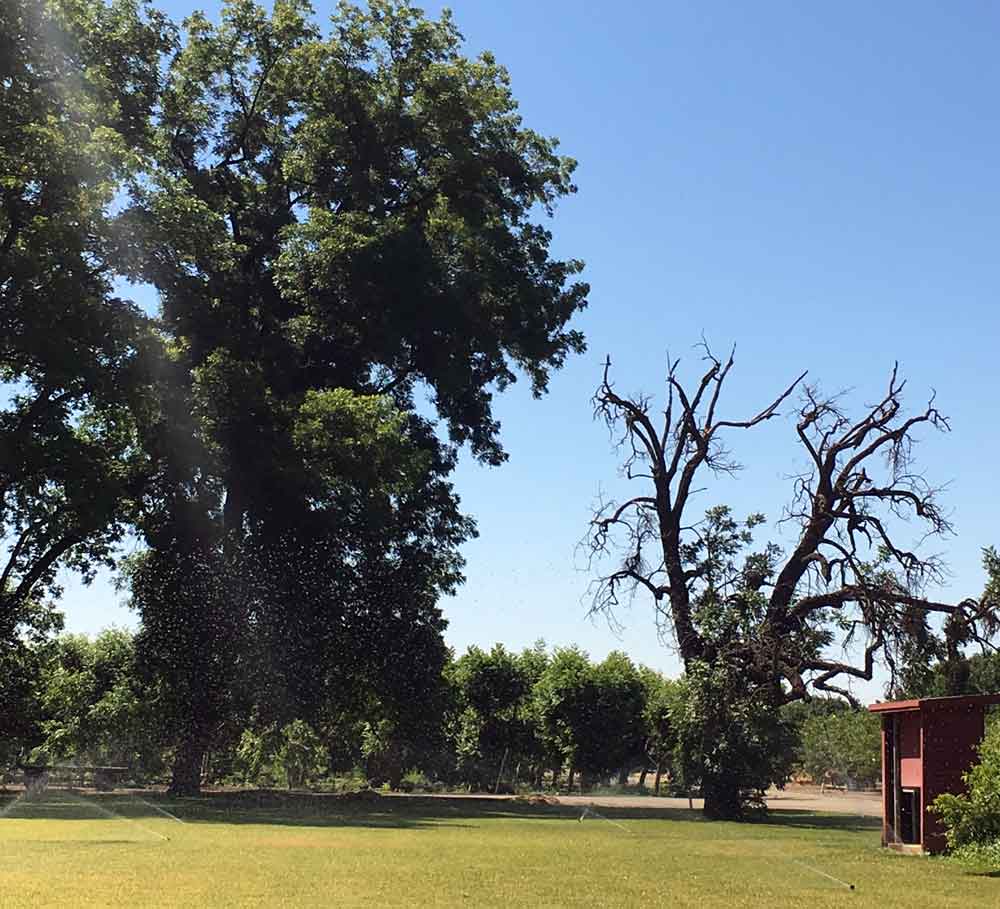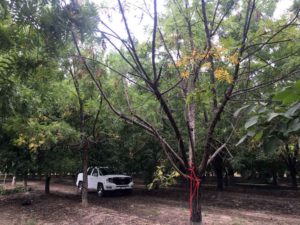
pecan trees at Wolfskill Experimental Orchards, Winters, taken
June 28, 2018. TCD does not impact pecans.
Smaller than a grain of rice, the invasive walnut twig beetle continues to threaten California walnut production by vectoring the fatal thousand canker disease (TCD).
A recent report in the Journal of Forestry confirmed this bark beetle species is associated with a recently described fungus, Geosmithia morbida, causing thousand canker disease.
The walnut twig beetle (WTB) is a native, phloem boring bark beetle that has invaded both native forest habitat and commercial walnut production. The WTB is native to the southwestern U.S., but has spread and impacted health of black walnut trees in many western states. The Journal reports that walnut trees have been killed in the primary U.S. Juglans germplasm repository in California and low, but measurable tree mortality has occurred in some English walnut orchards in the Central Valley. Tree decline and mortality appear to develop gradually in response to WTB infestations.
Walnut twig beetles tunnel into branches and trunks of trees where they create spaces for reproduction. These pests carry spores of the fungus and the resulting infections in the trees cause cankers which girdle branches.
Kathy Keatley Garvey at University of California Davis reports that between 2005 and 2016, TCD killed nearly 60 percent of the 210 specimens of southern California black walnut mature trees in

the United States Department of Agriculture (USDA) Agricultural Research Service’s National Clonal Germplasm Repository Juglans collection near Winters. Steven Seybold, USDA research entomologist said the loss is only an estimate and the true proportion of the mortality is likely much higher as only six of the 210 walnut trees were rated as having healthy crowns in 2016.
Seybold said the WTB is a significant pest of very large trees because it sequentially attacks the small branches, though ironically not the twigs, all the way down the trunk to the soil line. Most bark beetles are not that thorough in using all of the phloem tissues in their plant hosts, he said. Keatley-Garvey noted in the UC Entomology newsletter that a WTB attack on a 150-year-old black walnut tree on the school campus is gradually killing it.
Thousand canker disease has been found in many walnut growing counties since 2008 when it was first confirmed in Yolo County. Because most commercial walnut orchards trees are grafted onto native black or hybrid walnut (Paradox) rootstock and both rootstocks are highly susceptible to WTB attack, the journal reported that thousand canker disease presents an uncertain threat to California walnut production.
UC IPM program advises that good cultural practices and sanitation of infested wood are the primary strategies for disease management within orchards and for prevention of spread of TCD and WTB to regions with low rates of infection. Trees with less than 50 percent live crown should be removed to reduce the buildup of WTB and inoculum in the trunk and larger scaffold branches. Chemical control with either fungicides or insecticides is not recommended for management of TCD.











